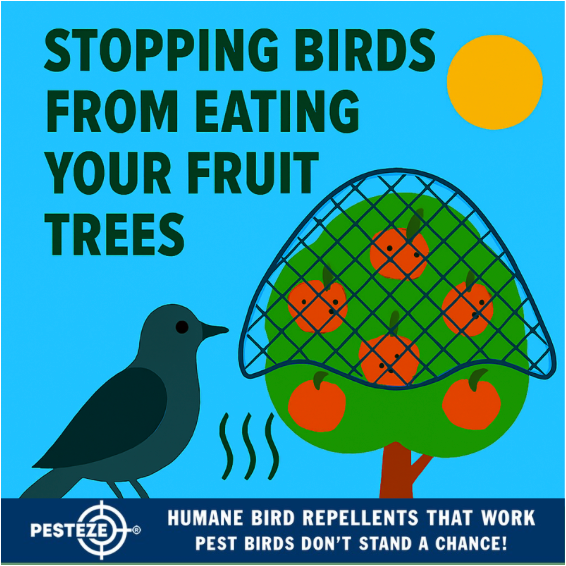STOPPING BIRDS FROM EATING YOUR FRUIT TREES

STOPPING BIRDS FROM EATING YOUR FRUIT TREES
SUMMARY
Birds can devastate fruit tree harvests by eating ripe fruit, damaging developing crops, and reducing yields significantly. This comprehensive guide provides effective strategies to protect fruit trees from bird damage while maintaining tree health and maximizing your harvest potential throughout the growing season.
FEATURES
- Harvest Protection: Shields ripening fruit from bird damage during critical harvest periods.
- Tree Health Maintenance: Methods that protect fruit without harming tree growth or development.
- Seasonal Strategies: Year-round protection adapted to fruiting cycles and bird migration patterns.
- Multiple Tree Types: Solutions for stone fruits, citrus, apples, berries, and specialty fruit varieties.
- Yield Maximization: Approaches that preserve maximum fruit production while deterring birds.
- Cost-Effective Options: Budget-friendly solutions alongside premium protection systems for all orchard sizes.
GUIDE DESCRIPTION
Fruit trees represent significant investments in time and money, but birds can destroy entire harvests in days once fruit begins ripening. Effective protection requires timing, proper materials, and methods that don't interfere with tree health, pollination, or fruit development while providing reliable deterrence throughout the vulnerable ripening period.
Netting systems provide the most reliable protection for most fruit tree applications. Fine mesh netting with 3/4-inch or smaller openings prevents bird access while allowing air circulation and light penetration necessary for proper fruit ripening. Proper installation techniques include securing netting completely around the tree canopy and ensuring ground contact prevents birds from accessing fruit from below.
Tree size considerations determine the most practical protection approach. Small fruit trees and dwarf varieties can be completely covered with individual nets, while large mature trees may require sectional protection focusing on the most productive branches. Scaffolding or support structures may be necessary for proper net installation on larger trees.
Timing protection installation correctly maximizes effectiveness while minimizing tree stress. Install barriers just as fruit begins showing color changes but before birds discover the ripening crop. Too early installation can interfere with pollination, while delayed installation allows birds to establish feeding patterns that become difficult to interrupt.
Alternative deterrent combinations work well for trees where netting isn't practical. Reflective tape, spinning devices, and noise makers positioned throughout the canopy create multiple sensory deterrents that birds find uncomfortable. Regular repositioning of these devices prevents habituation and maintains effectiveness throughout the harvest season.
Sacrificial planting strategies can redirect bird attention away from valuable fruit trees. Mulberry trees, elderberries, and other bird-preferred species planted at property edges provide alternative food sources that mature before or alongside your main fruit harvest. This approach works within natural feeding behaviors rather than against them.
Harvest timing modifications can reduce bird pressure by collecting fruit slightly before peak ripeness. Many fruits continue ripening after picking, allowing you to harvest crops before birds discover them while still achieving full flavor development. Multiple small harvests often prove more effective than waiting for complete ripeness on the tree.
Row cover applications work well for smaller fruit trees and bushes during critical ripening periods. Lightweight fabric covers allow light and air circulation while providing complete bird exclusion. Support hoops or frames prevent covers from resting directly on branches and fruit, which could cause damage or limit air circulation.
Chemical deterrent options include taste-based repellents that make fruit unpalatable to birds without affecting human consumption. Food-grade compounds applied according to label directions can reduce bird interest while maintaining fruit safety. Reapplication schedules typically require treatment every 7-14 days during peak ripening periods.
Tree maintenance practices can reduce bird attraction by eliminating factors that draw them to fruit tree areas. Regular cleanup of fallen fruit removes attractant materials, while proper pruning improves air circulation and makes trees less attractive for nesting. Water source management around orchards can influence bird activity patterns.
Integrated pest management approaches combine multiple deterrent methods for maximum effectiveness. Physical barriers during peak harvest combined with visual deterrents during early season development provide comprehensive protection. Monitoring bird activity patterns helps identify the most critical protection periods for each fruit variety.
Commercial orchard considerations require scalable solutions that balance protection costs with crop values. Mechanical harvesting schedules can be adjusted to minimize bird exposure time, while professional netting installation may prove cost-effective for high-value crops. Insurance considerations may favor documented bird protection efforts.
- Pukhraj Sharma


Comments 0